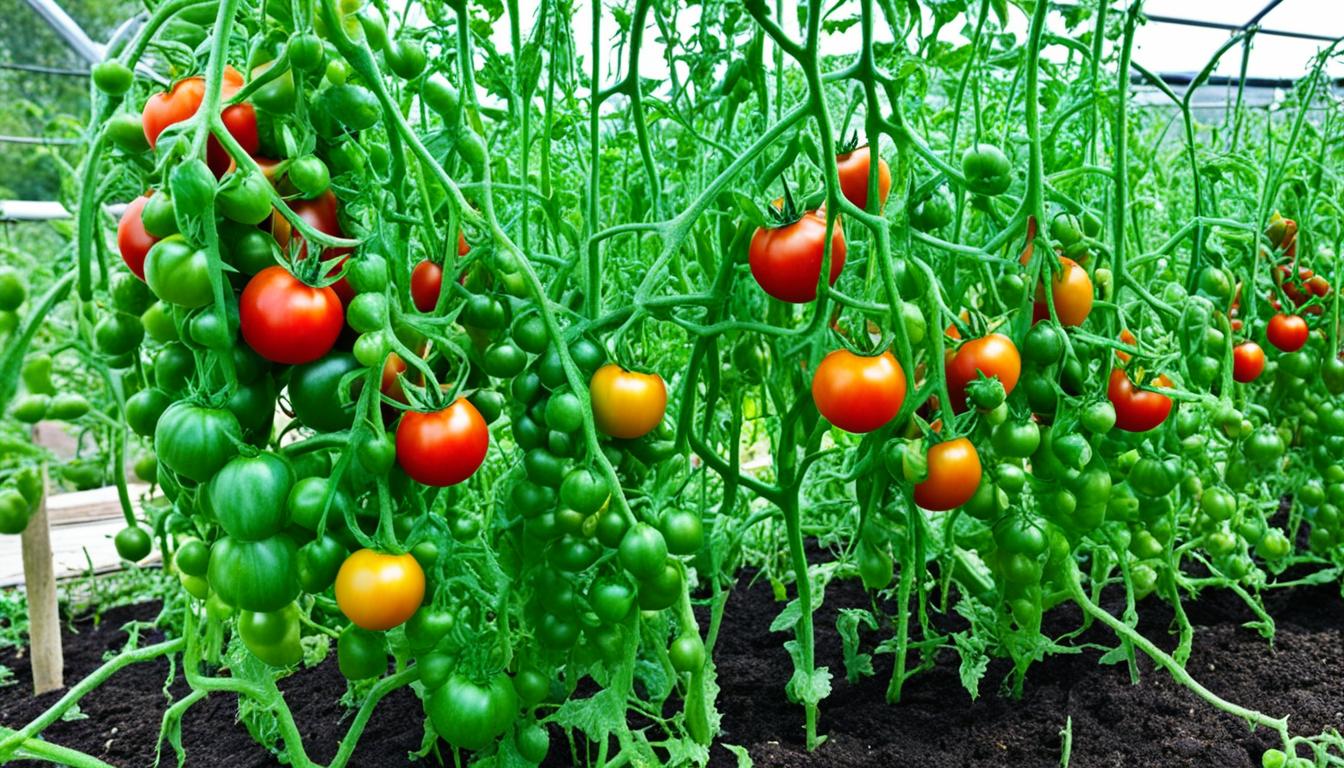Did you know a tomato starts changing color at the “breaker point”?
This key fact is part of many tomato myths. Lots of what we hear about tomatoes is like stories passed down. Often, these tales are not fully true.
This article will show which common tomato myths are fake and explain the real story.
Key Takeaways
- Around a third of a tomato’s fruit will have begun to change color when it reaches the “breaker point” or “breaker stage”.
- Temperatures over 78 degrees Fahrenheit can affect the taste of tomatoes, compelling gardeners to pick them at the breaker stage and ripen them indoors for better flavor.
- Aspirin, when used on tomatoes, can trigger a stress response in the plant but does not enhance pest resistance or treat diseases.
- Tomato plants tend to lose foliage as they age, with most of the plant’s energy directed towards fruit production instead.
- Refrigerating tomatoes can affect their flavor due to enzyme activity, leading to a perception of blandness when compared to freshly harvested ones.
Introduction
Tomatoes are loved all around the world, often mistaken for a vegetable when they’re actually a fruit. Their vibrant, juicy taste has won over people everywhere. Yet, many myths have surrounded tomatoes for centuries.
A Brief Overview of Tomatoes
In the Andes mountains, South America, tomatoes first appeared. The Aztecs and Incas grew them, looking like tiny cherries. At first, Europe thought they might be poison when they arrived in the 16th century. But, as uses grew and they proved safe, tomatoes earned a special place in dishes across the globe.
Why Myths About Tomatoes Exist
Tomatoes have a deep history and huge cultural importance. This has led to a lot of stories and myths. People not fully understanding them scientifically, differences in how they’re used in cooking, and the quest for the best way to grow tomatoes have all fueled myths and legends about them. Let’s explore these myths to find out what’s true and what’s not about these amazing fruits.
“Tomatoes are one of the most popular and widely-grown vegetables (or fruits, as we’ll discuss) in the world.”
Myth 1: Tomatoes Are Vegetables
Many think tomatoes are veggies, but it’s not true. Tomatoes are fruits scientifically. They grow from a plant’s flower’s ovary and have seeds. Yet, in the kitchen and by culture, we see them as vegetables. Why? Because they’re not sweet, like desserts, but savory.
Scientific Classification
Botanically, they fit in the nightshade family, Solanaceae. They’re the fruit of the Solanum lycopersicum plant. So, despite their taste and how we use them, they’re actually in the same group as berries.
Cultural and Culinary Classification
Even though they’re fruits, we treat them as veggies in cooking. This is because of their flavor and how they’re used. You find them with the veggies in stores and cooking guides. This mix-up has hung around, even with the facts showing tomatoes are fruits.
The wrong idea that tomatoes are veggies comes from how we cook with them. Knowing the real science can fix this mistake. Tomatoes have an interesting story and role in our culture.
“Tomatoes are botanically classified as fruits, but they are commonly used and perceived as vegetables in the culinary world. This discrepancy between scientific and cultural classification is a source of ongoing confusion and debate.”
Myth 2: Tomatoes Are Poisonous
For centuries, people thought tomatoes were poison. This idea started in the 1700s. The European nobles thought tomatoes were toxic. They didn’t eat them. This happened during the “witch craze.” Thousands of witches were killed then. Tomatoes came to Europe in 1540, the same time as the witch hunts.
Origin of the Myth
Several events led to the idea that tomatoes were harmful.
In 1850, doctor Dio Lewis linked tomatoes to health problems. He said they should be avoided because they were very medicinal. Even after the U.S. Civil War, many English people and their New England descendants didn’t eat tomatoes. They saw them as dangerous or tied to satanism.
This fear of tomatoes lasted in some areas until 1860. This is where the term “the tomato effect” came from. It explains how people avoid helpful treatments for cultural reasons.
The Truth About Tomato Toxicity
Tomato leaves and stems do have some toxins. But, the tomato fruit itself is not poisonous. You can eat them safely in normal amounts. There is a substance called tomatine in all green parts of the tomato plant. This includes the stems, leaves, and unripe tomatoes.
But, humans don’t absorb it well. It mainly passes out of the body in urine or feces. You’d need to eat a lot of tomato leaves to get a harmful dose.
The myth that tomatoes are poisonous led to new stories. One story said tomatoes were dangerous because they were put on pewter plates. Wealthy Europeans used these plates. They were high in lead. When tomatoes touched them, people got lead poisoning and died. But, only three stories mentioned tomato dangers in American writing before 1860.
Despite carrying some toxins in leaves and stems, tomatoes themselves are not poisonous. They are safe to eat in normal amounts. This old myth about tomato toxicity comes from wrong beliefs in the past. But, we now know tomatoes are safe and good for us to eat.
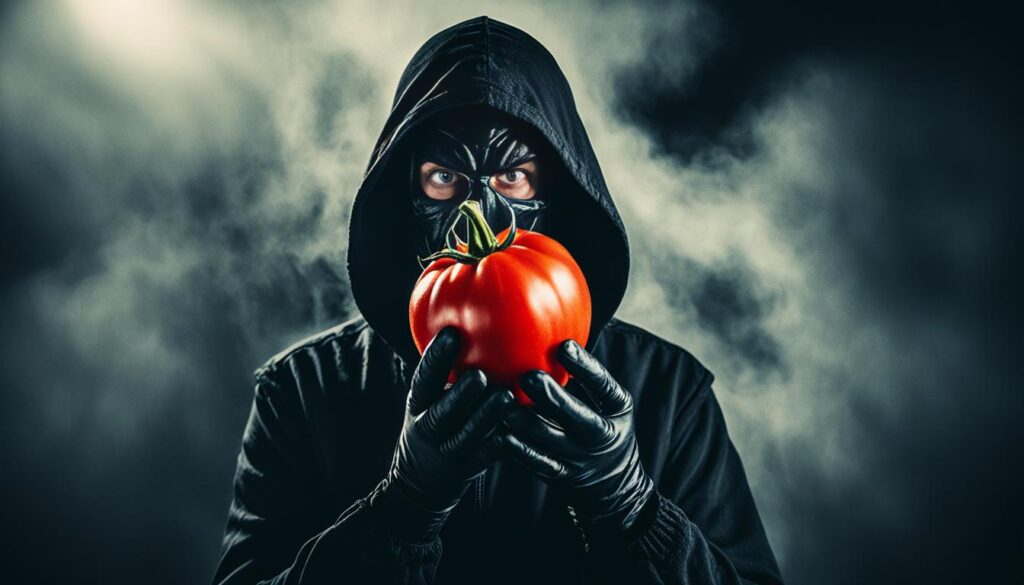
Myth 3: Tomatoes Need Full Sun All Day
Many think tomato plants need the sun all day to grow well. They actually do better with some shade from midday sun. The best for tomatoes is 6-8 hours of sun, with a break in the middle of the day.
Tomatoes like warmth, but too much heat over 90°F can hurt them. It leads to problems like dropping flowers and less fruit setting. The little cherry tomatoes do better in the heat than big kinds.
When it’s very hot, helping out with pollination can be useful. Using tools like VegiBee or electronic toothbrushes can make tomato flowers shake like when insects visit. Tomatoes must self-pollinate soon after the flower opens to make fruit. But, bees are not a must for tomatoes to make fruit.
Gardeners who know about sunlight and help with pollination can keep their tomatoes healthy. They can still do well in hot, humid times. Learning about caring for tomatoes leads to a great harvest.
“Tomatoes do best with 6-8 hours of direct sunlight per day, with some protection from the intense midday sun. This helps them avoid the negative impacts of extended heat exposure.”
Myth 4: Heirloom Tomatoes Are Always Better
Some think heirloom tomatoes are always better than hybrid ones. They believe this for taste, nutrition, and quality reasons. But, both heirloom and hybrid tomatoes have good and bad points.
How and where tomatoes grow matters more than if they’re heirloom or hybrid. Your personal taste also affects the flavor. New breeding and growing ways let hybrid tomatoes taste as good and be as healthy as some heirlooms.
Comparison with Hybrid Tomatoes
Heirlooms are loved for their unique flavors. These can be sweet, fruity, tangy, or savory. But, hybrids fight off diseases better, give more produce, and last longer. That’s why people grow them at home or on farms.
Flavor, Nutrition, and Growing Differences
Heirloom tomatoes have many flavors, but hybrids can taste great too. Sometimes, hybrids can be even healthier. Hybrids are also easier to grow and tougher, which is good for beginners or small spaces.
Choosing heirloom or hybrid tomatoes is up to you. Think about what you like, where and how you grow them. Both types add to the wonderful world of tomatoes.
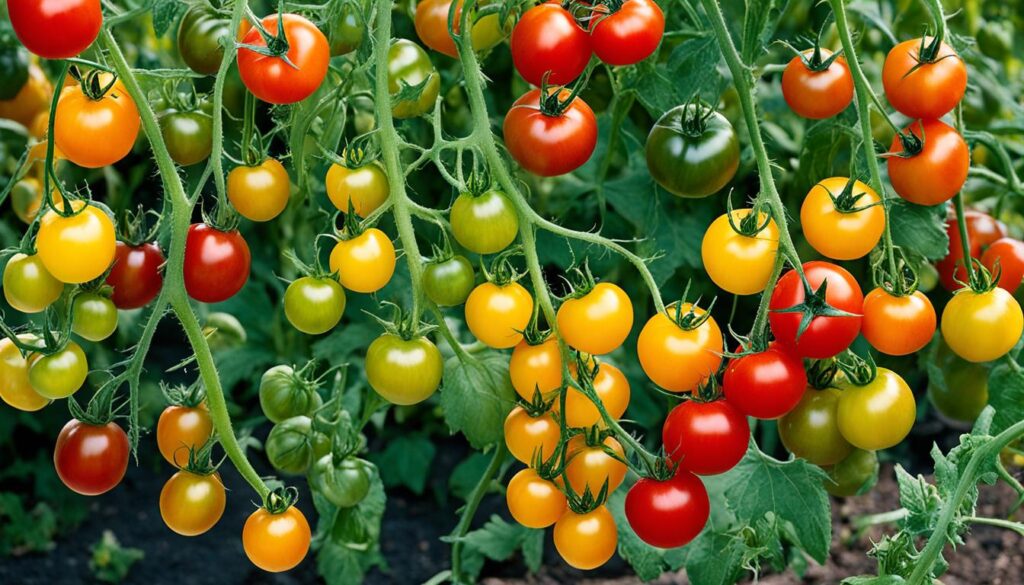
| Characteristic | Heirloom Tomatoes | Hybrid Tomatoes |
|---|---|---|
| Flavor | Rich, complex, and diverse | Consistent, often sweet and mild |
| Nutrition | Variable, depending on variety | Generally high, with improved disease resistance |
| Growing Requirements | More sensitive to growing conditions | More resilient and easier to grow |
| Yield | Lower, sometimes inconsistent | Higher, more consistent |
| Shelf Life | Shorter, more perishable | Longer, more durable |
“Both heirloom and hybrid tomatoes have their own unique strengths and weaknesses. The key is to choose the variety that best fits your gardening needs and personal taste preferences.
Thinking heirlooms are always better is a myth. Yes, they offer diverse flavors. But, hybrids bring good taste, health, and growing features too. Your choice hinges on what you like, how you grow, and what you need.
Myth 5: You Should Refrigerate Tomatoes
Many think keeping tomatoes in the fridge is good. But, it can harm their taste and feel. The fridge can make them mushy and lose their sweetness. A debate started on Facebook about where to put tomato sauce. Only two liked keeping it in a cupboard.
Impact of Refrigeration on Flavor and Texture
Putting tomatoes in the fridge messes with how they taste and feel. It makes them too wet, soft, and less sweet. Some argued strongly for or against putting sauce in the fridge.
Best Storage Practices
Tomatoes do best in room temperature, away from the sun. A food safety spokesperson suggests it’s okay to chill tomato sauce now. It’s due to healthier ingredients and less salt.
But, it might not be good for fresh tomatoes. The cold can mess up how they taste and feel. Many now choose to keep tomato sauce in the fridge for safety.
Keep tomatoes at room temp for best quality. Only chill them if they’re too ripe. Lydia Buchtmann notes sauce labels say to fridge it. But, this doesn’t always go for fresh tomatoes.
“The cold temperature of the refrigerator can actually damage the texture and flavor of tomatoes, causing them to become mealy and lose their natural sweetness.”
Myth 6: Tomatoes Are Always Red
Many think of tomatoes as just red, but that’s not true. They can be yellow, orange, pink, purple, and even black. These colors show different tastes and nutrients in tomatoes. Trying different colored tomatoes can make cooking fun and interesting.
Variety of Tomato Colors
Heirloom tomatoes are not just red. They come in many colors. Purple and black tomatoes bring deep flavors. Yellow and orange ones are sweet. Each color has its own taste and good for you too.
- Yellow tomatoes are often sweeter and less acidic, making them a great choice for salads and sauces.
- Orange tomatoes tend to be high in beta-carotene, which can provide a boost of vitamin A.
- Purple and black tomatoes derive their color from anthocyanins, antioxidants that may offer additional health benefits.
Nutritional and Flavor Differences by Color
Tomatoes come in many colors that look pretty and taste different. While red ones are rich in lycopene, other colors have their own benefits. Yellow and orange tomatoes have beta-carotene and vitamin C. Purple and black tomatoes offer anthocyanins for health.
| Tomato Color | Nutritional Highlights | Flavor Profile |
|---|---|---|
| Red | High in lycopene, a powerful antioxidant | Tart and acidic |
| Yellow/Orange | Rich in beta-carotene and vitamin C | Sweet and mild |
| Purple/Black | High in anthocyanins, known for their anti-inflammatory properties | Earthy and complex |
Try out different tomato colors for a change in your meals. Not only do they look interesting, but they also offer unique tastes and health benefits.
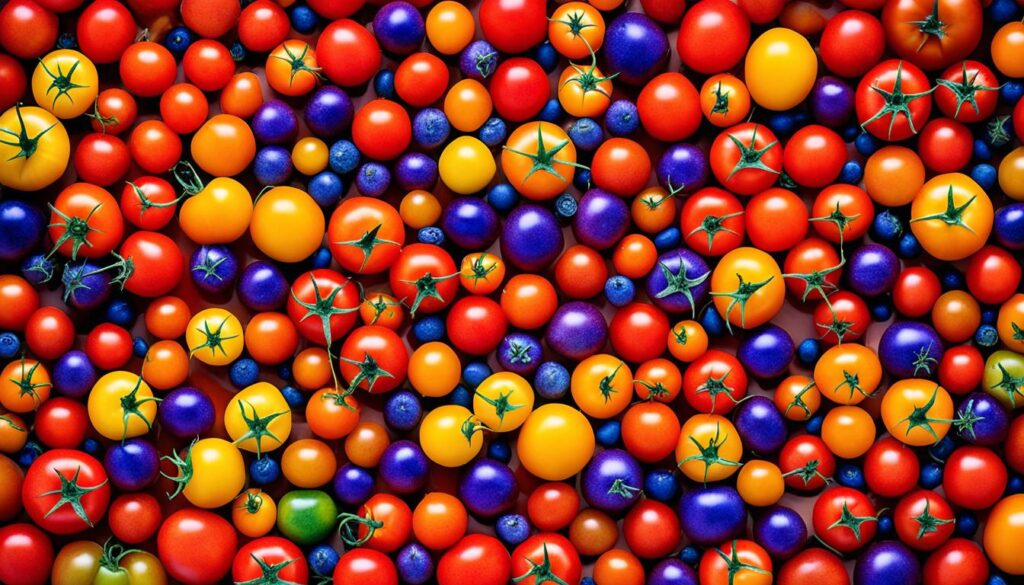
Learning about all tomato colors can be very enjoyable. It will help you love their varied tastes and health perks. So, enjoy the colorful world of tomatoes.
Tomatoes come in a rainbow of colors, each with its own distinctive taste and health benefits. Exploring this vibrant diversity can transform your cooking and delight your senses.”
Myth 7: You Can Eat Tomato Leaves
Some believe we can eat tomato leaves, but that’s wrong. These leaves have a bit of a toxin called tomatine. It’s in all parts of the plant but leaves and stems have more. If you eat a lot of leaves, you could get sick. Stick to eating the fruit, stems, and flowers, and be careful. It’s smart to only eat what’s safe and avoid the rest.
Toxicity of Tomato Leaves
Tomatine is a kind of glycoalkaloid that’s not good for us in large amounts. It’s mostly in the leaves and stems. Too many leaves can make you sick. You might feel nauseous, vomit, have diarrhea, or even worse. So, remember, no eating tomato leaves. Keep them away from kids and pets too.
Safe Parts of the Tomato Plant to Eat
Stay away from the leaves, but the fruit, stems, and flowers are okay. Tomatoes are loved all over the world. The fruit is really a berry and it’s the main part we eat. You can also eat the stems and flowers, but they taste a bit different.
Still, some people might not do well with tomatoes. Always be careful with new foods. Try a little first, and see how you feel. By doing this, you can enjoy the great taste and benefits of tomatoes safely.
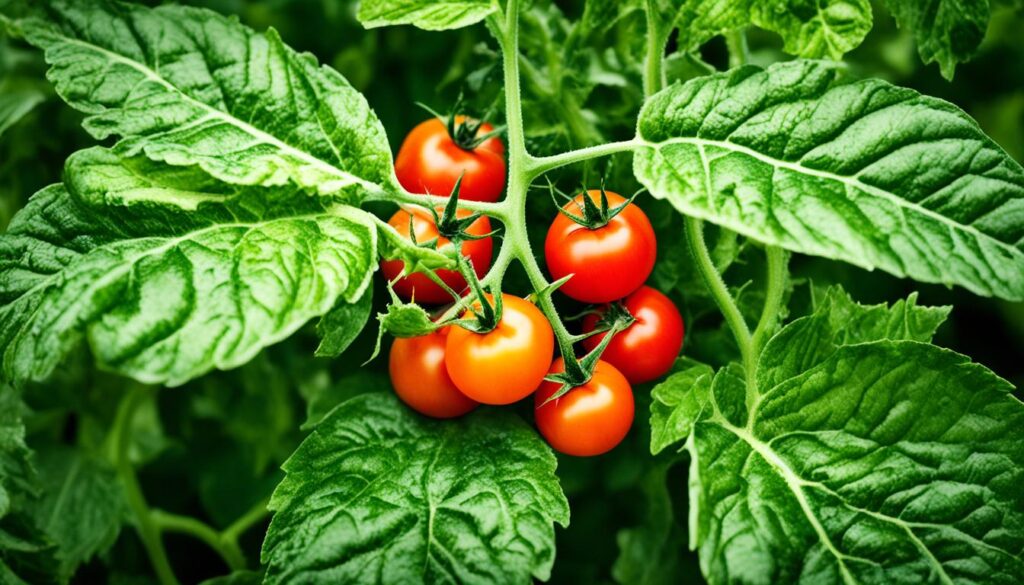
“Tomatoes are a popular and versatile food that has been embraced around the world.”
Conclusion
Learning about tomatoes has been enlightening. We found out that they’re either fruits or vegetables. They come in many types, offering different tastes, colors, and ways of growing.
By clearing up facts and myths, we’ve learned a lot about tomatoes. We now know the real deal about San Marzano tomatoes. Plus, we’ve seen the many old and new kinds out there to try.
I invite you to keep exploring tomatoes, no matter who you are. Whether you love growing them, are into cooking, or just love their flavor, there’s a lot to enjoy. Try new varieties, learn better ways to grow them, and question the old myths.
FAQ about Crazy Tomato Myths
Are tomatoes a fruit or a vegetable?
Tomatoes are fruits according to science. They grow from a plant’s ovary and have seeds. But, in the kitchen, people think of them as vegetables. This is because they’re not sweet.
Are tomatoes poisonous?
Long ago, in the 1700s, some thought tomatoes were deadly. The rich in Europe didn’t eat them. The reason was they believed tomatoes were toxic. It turned out, the leaves and stems only contain a little poison, not the fruit.
Do tomatoes need full sun all day long?
Lots think tomatoes need sun all day. But, they can do well in a bit of shade. The best light for tomatoes is 6 to 8 hours of sun. It’s good if they’re not in full sun all day.
Are heirloom tomatoes always better than hybrid tomatoes?
Some say heirloom tomatoes taste better and are healthier. Yet, what makes a tomato good depends on some things. Like how it was grown and what you like. Both heirlooms and hybrids are worthy.
Should I refrigerate my tomatoes?
It’s not true that the fridge is good for tomatoes. The cold can ruin their taste and feel. It’s better to keep them on the counter, away from sun. Only fridge them if they’re too ripe.
Are all tomatoes red?
Not all tomatoes are red. They can be yellow, orange, pink, purple, or black too. These colors show they have different tastes and health benefits.
Can I eat tomato leaves?
Eating tomato leaves is a bad idea. They have a little poison. Stick to the fruit, stems, and flowers for safe eating.
Source Links
- https://www.ruralsprout.com/tomato-growing-myths/
- https://www.ancient-origins.net/weird-facts/tomatoes-0017476
- https://www.quiltingboard.com/general-chit-chat-non-quilting-talk-f7/your-tomatoes-making-you-crazy-t228018.html
- https://cals.cornell.edu/school-integrative-plant-science/school-sections/horticulture-section/outreach-and-extension/pandemic-vegetable-gardening/pandemic-vegetable-gardening-2020-archive/vegetable-myths-legends-and-outright-lies
- https://www.gardenstead.com/the-history-of-the-tomato/
- https://www.express.co.uk/life-style/garden/1748171/tomato-growing-myths-to-avoid
- https://www.atlasobscura.com/articles/when-tomatoes-were-blamed-for-witchcraft-and-werewolves
- https://gardenbetty.com/tomato-leaves-the-toxic-myth/
- https://www.metafilter.com/166408/The-Deadly-Tomato
- https://joegardener.com/podcast/how-heat-affects-tomato-plants-how-to-protect-craig-lehoullier/
- https://horticulturetalk.wordpress.com/2013/06/10/mythbusters-gardening-edition/
- https://www.smithsonianmag.com/arts-culture/why-the-tomato-was-feared-in-europe-for-more-than-200-years-863735/
- https://www.libraryseedbank.info/ee16ltsm0bwu49hxfzcsoxbhmgq8pb/tag/heirloom tomatoes
- https://www.dailymail.co.uk/news/article-5384067/Do-really-need-store-tomato-sauce-fridge.html
- https://theretrobliss.medium.com/the-us-was-terrified-of-tomatoes-5b57239803ee
- https://www.ktvb.com/article/news/local/jims-list-of-25-garden-myths-and-old-wives-tales/277-273583508
- https://www.rd.com/article/are-tomatoes-poisonous/
- https://tastecooking.com/fake-rolex-canned-tomatoes/
- https://www.nytimes.com/2008/05/04/books/review/Ferguson-t.html
- https://www.aljazeera.com/opinions/2023/12/13/its-not-shocking-to-see-israeli-children-celebrate-the-gaza-genocide
